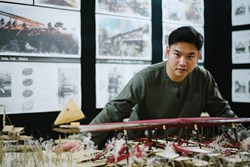Hunter Dale from Te Kura Matatini ki Otago — Otago Polytechnic, School of Architecture is a finalist for his project 'Filling in the Gaps; Reimagining Underutilised City Space to Promote Sustainable Intensification | ft. (car)Park Life'.
Project description
New Zealand’s growing housing shortage, coupled with a reliance on urban sprawl, has produced cities that expand outward as the predominant method of residential growth. This approach is widely acknowledged for its negative impact on both community wellbeing and the natural environment. Filling in the Gaps explores an alternative to this approach by investigating the existing dense urban fabric to ‘find space’. The project identifies underutilised and forgotten spaces as opportunities to create new places for living.
The design, titled (car)Park Life, demonstrates how adaptive reuse and urban densification can activate existing space. By transforming an existing car parking building in central Dunedin, the project reimagines the existing building as a mixed-use vertical neighbourhood. Through a series of additions and subtractions, the structure is converted into desirable apartments that prioritise quality living and urban integration.
At the street level, an attachment onto the building engages directly with the street front and takes design cues from the surrounding heritage facades. An addition above becomes a contemporary expression of a mansard roof that relates to Dunedin’s skyline.
A strategic design move slices through the existing building, connecting View Street to the Octagon, the heart of Central Dunedin. This intervention opens the building to the city, creating a new activated ‘street’ that encourages movement, visibility, and engagement between residents and the public.
The proposal challenges the conventional detached dwelling model by emphasising shared resources, community interaction, and a balance of public and private spaces. Apartment typologies are distributed across multiple levels to promote diversity in living arrangements, while commercial and communal areas are integrated throughout the building to promote interaction. The result is a desirable high-density, multifunctional apartment building that enhances Dunedin’s urban fabric, stemming further urban sprawl.






